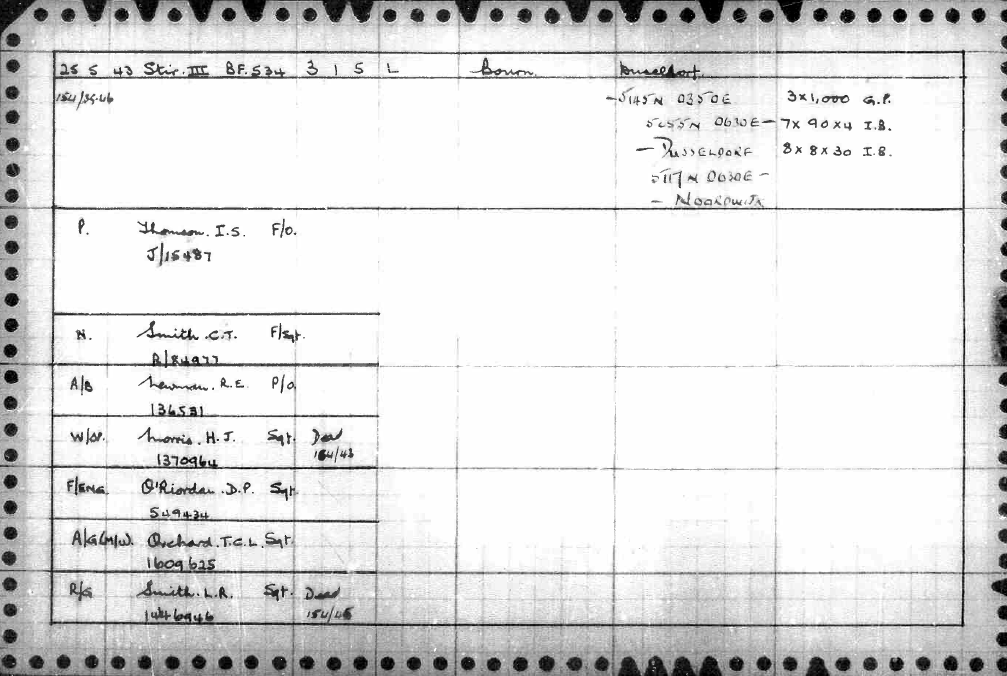25/26th May 1943




Aircrew
Aircraft
Stirling III, Serial No: BT534
The Stirling was the first British four-engined bomber of World War II. This Stirling III version was built by Short and Harland and delivered to RAF 15 Squadron on 23 Apr 1943. It bore the X1D (Identification) of LS-L and was powered by Bristol Hercules engines.

The Stirling was very agile and praised for its ability to out-turn enemy night fighters and for its good handling characteristics, but its relative poor altitude ceiling was often a subject of criticism. When Stirlings were on operations with other RAF bombers which could fly higher, the Luftwaffe tended to concentrate on the Stirlings.
LS-L had taken off at 23.57 on the evening of 25 May 1943 on a bombing mission to Düsseldorf, when it was brought down by the blast of Halifax KN-D at 01.51 at an approximate height of 4700 metres (15,400ft), and crashed south of Jülich near Gut Lorsbeck, killing all crew.

Luftgaukommando VI Münster Report
Whenever an allied aircraft crashed in Germany, or in German occupied territory, the scene was very quickly quarantined and the aircraft examined. A Luftgaukommando was an administrative command of the Luftwaffe responsible for air defence and support services. Luftgaukommando VI, based in Münster, was responsible for the area around Jülich. It published a report "Untersuchung von Nachrichtegërat in Abgeschossenes Feindflugzeugen" on 28th May 1943 covering the previous two nights' raids, detailing the electronic equipment that had been discovered in the crashed bombers [13]. A scan of the original report into BF534 is shown in German on the left, and the translation into English on the right
Untersuchung von Nachrichtegërat in Abgeschossenes Feindflugzeugen |
Investigation of Communication Devices in Downed Enemy Aircraft |
|---|---|

|
4.) Julich - Gut Lorsteck : [possibly a mistype of Lorsbeck] |
Loss Card
Bomber Command created a Loss Card [14] for each aircraft that failed to return from an operational flight. The data recorded on the cards normally includes the names of the crew, their fate, the route taken and bomb load. In some cases information from survivors has also been added, and post-war research regarding the crew and aircraft. The handwriting is notoriously difficult to decipher.

The front of the Loss Card for BF534 shows the planned route was 51 45N 03 50E to 50 55N 06 36E to Dusseldorf to 51 17N 00 30E to Noordwijk. The bomb load was 3 x 1000lb GP bombs, 7 x 90 x 4lb incendiary bombs and 8 x 8 x 30lb incendiary bombs.
The Loss Card shows a reference number followed by the numbers for each body found (whether identified or not). The reference is 154/39-46 where 43 = Morris and 45 = L.R.Smith. Interestingly, the other numbers, 39, 40, 41, 42 and 44 refer to crewmen of Stirling EF361 which crashed at the same time as BF534. 46 is an unidentified body thought to be associated with EF361. The fate of
Thomson, C.T.Smith, Newman, O'Riordan and Orchard is not reported which suggests that no identifiable remains were ever found,

The rear of the Loss Card reads:
154/39-46 2 identified + 5 of crew of 7 Sq EF361 + 1 unknown
Shot down 26.5.43. Burial not reported
Squadron
In May 1943, RAF 15 Squadron, based at Mildenhall.